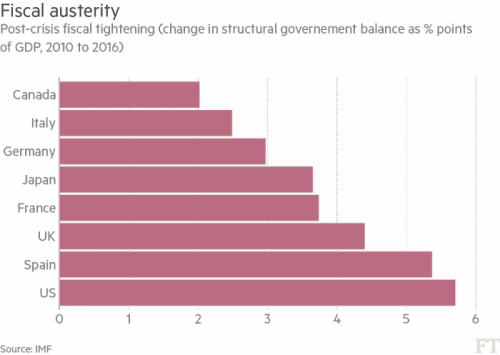Some thoughts on full employment and this asset-based economic recovery
I see that Dartmouth economics professor Danny Blanchflower is talking about slack in the US labour market because he believes the Fed is premature in assessing its full employment mandate as fulfilled.
I have a few thoughts on this issue I want to flesh out below and the crux of my narrative revolves around the over-dependence on monetary policy as a policy lever.
First, let’s remember that some eight years ago, the US stock market was in the dumps, with the S&P 500 trading down to a multi-decade low of 666. Yesterday, the S&P 500 closed near its record high, at 2459, putting the 8-year gain at 270%. Spectacular.
But when one looks at the real economy, the results are middling, not spectacular. Nominal GDP growth has declined into a channel below 5% like the post-bubble Japanese economy. And that’s not just because of declining inflation. Real GDP growth has been of the 2%ish variety, briefly hitting the 3% level on only few occasions. That’s much worse than previous US expansions. So former US Treasury Secretary Larry Summers is calling this outcome secular stagnation.
But what’s more relevant is the jobs and inflation picture, where the Fed’s mandates are. Inflation has been below the Fed’s 2% target for five years and broader measures of unemployment continue to show slack. It’s this real economy picture that has Blanchflower criticizing the Fed’s rate hike train.
But let’s take a step back and ask why the Fed was at zero to begin with and why it’s still at 1% now even though this business cycle is in it’s ninth year already.
My answer is that monetary policy is the only game in town. In fact, if you look at the US compared to the rest of the G-7, fiscal policy has been tighter in the US than in any other country. It’s been even tighter than Spain, which has been forced to cut under the EU’s excessive deficit procedure.
It’s a Herculean task to ask the Fed to ‘fix’ the US economy after the greatest global financial crisis in 80 years, especially when the structural government balance has tightened almost 6%.
This is exactly the problem. The dichotomy between the real economy and the financial economy is so acute because of this asset-based economic model. Financial assets are through the roof because US corporations have increased earnings by controlling expenses, buying back stock, and raising lots of debt. The Fed’s policy of keeping rates at zero and buoying financial assets through QE has given companies the breathing room to achieve these results.
Meanwhile, in the real economy, many households have had to climb from under a mountain of debt and wait for house prices to rise enough to bring them from underwater positions on their homes. And job growth and median wage growth have been middling at best in this recovery.
So now we are at a point where the economy is in a much better place. And the Fed is understandably worried that – as the only game in town – it needs to normalize rates as soon as possible. The immediate question Danny Blanchflower is asking is whether the Fed’s desire to normalize is premature and whether that eagerness will lead to bad outcomes – continued high structural unemployment and inequality or even recession. I think that’s a good question.
But my focus is actually on the next recession. For one, I think the US economy has proved resilient this cycle, having powered through a monumental oil sector capex bust in 2014 and 2015 and regaining momentum last year. And right now there are no immediate signs of recession on the horizon. But what happens when the cycle turns down? Janet Yellen tells us there won’t be another crisis. But I’m not so sure. Every cyclical downturn since the end of Bretton Woods has meant crisis: 1973-1975, 1980-1982, 1990-1991, 2000-2001 and 2007-2009.
The next cyclical downturn may not mean a crisis as big as the last crisis. But that doesn’t mean the excess in subprime auto, student loans or commercial real estate won’t combine to create another crisis – especially for small and medium-sized banks. And if that crisis comes anytime soon, with rates at 1%, the Fed’s policy tools will be more limited than they were in the last cycle.
And with secular stagnation as our policy choice, I believe the impact of even a mini-crisis and recession on financial assets will be much larger than is presently anticipated, which will, in turn, amplify that sense of crisis.
To be continued…
P.S. – Think about this in the context of the debt ceiling debate, which I addressed on CBC’s On The Money program in this clip the same day this post was published.

Comments are closed.